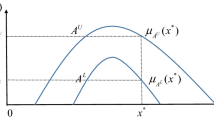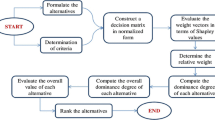Abstract
GIS-based data fusion is now considered as a common methodology for selecting appropriate sites to locate government or company sites. Due to the success of GIS-based approaches, its UI system becomes very important in service promotion aspects. In particular, UI system presented to general public has to be intuitive and effective to cope with multi-criteria decision making problems (MCDM) which become majority in GIS-based selection problems. In this paper, based on the fuzzy measure and fuzzy integral method for dealing with GIS–MCDM problems, an intuitive UI system for GIS–MCDM is proposed by modifying conventional UI using diamond pairwise comparison diagram focusing on using the easy-to-understand terms and coinciding appropriate meaningful directions with human`s intuitive understanding. In addition, strategy for applying the fuzzy measure and fuzzy integral method along with the proposed UI system upon the public service is also described considering the distributional aspects of computational burden to process data fusion calculation efficiently.






Similar content being viewed by others
References
V-world. Retrieved. http://www.vworld.kr. Accessed March 14, 2016.
Statistical geographic information service plus (SGIS+plus) of statistics Korea. http://sgis.kostat.go.kr/view/board/sopIntro. Accessed March 14, 2016.
Rikalovic, A., Cosic, I., & Lazarevic, D. (2014). GIS based multi-criteria analysis for industrial site selection. Procedia Engineering, 69, 1054–1063.
Ardeshir, A., Mohseni, N., Behzadian, K., & Errington, M. (2014). Selection of a bridge construction site using fuzzy analytical hierarchy process in geographic information system. Arabian Journal for Science and Engineering, 39(6), 4405–4420.
Meng, Y., & Malczewski, J. (2015). A GIS-based multicriteria decision making approach for evaluating accessibility to public parks in Calgary, Alberta. Human Geographies, 9(1), 29.
Khavarian-Garmsir, A. R., & Rezaei, M. R. (2015). Selection of appropriate locations for industrial areas using GIS-fuzzy methods. A case study of Yazd Township, Iran. Journal of Settlements and Spatial Planning, 6(1), 19.
Bahrani, S., Ebadi, T., Ehsani, H., Yousefi, H., & Maknoon, R. (2016). Modeling landfill site selection by multi-criteria decision making and fuzzy functions in GIS, case study: Shabestar, Iran. Environmental Earth Sciences, 75(4), 1–14.
Park, M. J., & Choi, S. W. (2008). Development of an inundation risk evaluation method based on a multi criteria decision making. Journal of Korea Water Resources Association, 41(4), 365–377.
Lee, G. H., Shin, J. Y., & Shin, S. H. (2010). The research on the location suitability analysis of the city museum using the GIS-based multicriteria decision analysis: A case study of Incheon. Journal of the Korean Urban Geographical Society, 13(3), 80–105.
Jung, H. J., & Lee, J. Y. (2015). Analysis of eunpyeong new town land price using geographically weighted regression. Journal of Korea Spatial Information Society, 23(5), 54–73.
Kim, T. H., Han, K. Y., & Kwak, Y. M. (2012). Detailed flood vulnerability analysis using multi criteria decision making. Procedia Korean Society of Civil Engineers, 2012(10), 1886–1889.
Han, B. G., & Chung, E. S. (2013). Application of fuzzy multi-criteria decision making techniques for robust prioritization. Journal of The Korean Society of Civil Engineers, 33(3), 917–926.
Lee, J. H., Lee, J., & Kwon, Y. J. (2015). A proposal of a mobile augmented reality service model based on street data, and its implementation. Journal of Korea Spatial Information Society, 23(5), 9–19.
Mardani, A., Jusoh, A., & Zavadskas, E. K. (2015). Fuzzy multiple criteria decision-making techniques and applications—Two decades review from 1994 to 2014. Expert Systems with Applications, 42(8), 4126–4148.
Dursun, M., Karsak, E. E., & Karadayi, M. A. (2011). Assessment of health-care waste treatment alternatives using fuzzy multi-criteria decision making approaches. Resources, Conservation and Recycling, 57, 98–107.
Kuo, Y. C., Lu, S. T., Tzeng, G. H., Lin, Y. C., & Huang, Y. S. (2013). Using fuzzy integral approach to enhance site selection assessment—A case study of the optoelectronics industry. Procedia Computer Science, 17, 306–313.
Bottero, M., Ferretti, V., & Mondini, G. (2013). A Choquet integral-based approach for assessing the sustainability of a new waste incinerator. International Journal of Multicriteria Decision Making 73–74, 3(2–3), 157–177.
Grabisch, M., & Labreuche, C. (2005). Fuzzy measures and integrals in MCDA. In J. R. Figueira, S. Greco, & M. Ehrgott (Eds.), Multiple criteria decision analysis: State of the art surveys (pp. 563–608). New York: Springer.
Takahagi, E. (2008). A fuzzy measure identification method by diamond pairwise comparisons and ϕ s transformation. Fuzzy Optimization and Decision Making, 7(3), 219–232.
Yoo, J. K., & Kim, J. H. (2012). Fuzzy integral-based gaze control architecture incorporated with modified-univector field-based navigation for humanoid robots. IEEE Transactions on Systems, Man, and Cybernetics, Part B: Cybernetics, 42(1), 125–139.
Acknowledgments
This research was supported by a Grant (13 Urban Planning & Architecture 02) from Spatial Information Open Platform Infra Technology Development Research Project funded by Ministry of Land, Infrastructure and Transport government.
Author information
Authors and Affiliations
Corresponding author
Rights and permissions
About this article
Cite this article
Yoo, JK., Kim, M.S. UI proposal using modified diamond pairwise comparison diagram for fuzzy integral-based GIS–MCDM. Spat. Inf. Res. 24, 303–311 (2016). https://doi.org/10.1007/s41324-016-0031-0
Received:
Revised:
Accepted:
Published:
Issue Date:
DOI: https://doi.org/10.1007/s41324-016-0031-0




